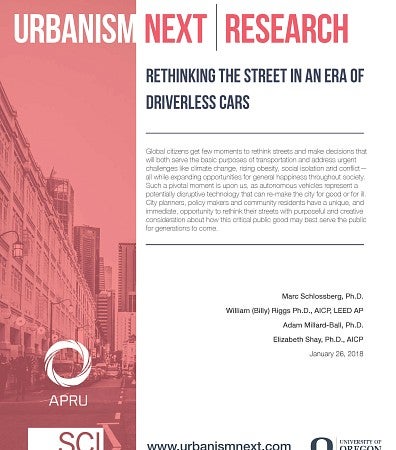
Driverless cars are about to hit the roads, and the roads are going to change along with them. Your community may need 90% fewer parking spaces. The number of vehicles on the road could be cut to a third of the current number while still accommodating the same travel needs. And your future vehicle trips could be completely free to you. Welcome to the 2020s.
The impacts of autonomous vehicles (AVs) have the potential to remake cities for good or for ill. Rethinking Streets in the Era of the Driverless Car is the latest white paper from Urbanism Next and was co-authored by SCI Co-Director Marc Schlossberg along with colleagues Billy Riggs, Elizabeth Shay, and Adam Millard-Bell. The report examines the many ways AVs present an opportunity to re-capture and re-envision our streets, one of the largest public land sources in most of our cities.
AVs will likely require fewer, narrower lanes and less parking than traditional vehicles. They may even be able to share bi-directional lanes. This frees up space that can be used for a broad range of beneficial public and private uses including non-auto transportation, housing, retail, recreation, ecological corridors, and more. As the report suggests, “Schools could extend their presence and activities into former parking or travel lanes; household gardens or community agriculture could fill small spaces; art or cultural activities – creation, performance, instruction – could find a platform. When given a newly blank canvas, our communities may be quite creative with imagining how to fill it.”
Rethinking Streets in the Era of the Driverless Car explores important questions of access, equity, economic and social exchange, infrastructure, and public use that will guide how cities choose to prepare for the arrival of AVs. With General Motors preparing to launch a fleet of AVs in 2019 and Ford looking to do the same in 2021, now is the time for cities to seize the potential to transform.
